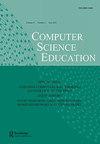协同发展计算思维:小团体内计算实践的联系
IF 2.2
Q1 EDUCATION & EDUCATIONAL RESEARCH
引用次数: 1
摘要
计算思维是中学计算教育的重要组成部分。这种教育水平的协作和协作设计活动的现有实践与CT实践很好地结合在一起,但这种相互作用在现有文献中尚未得到充分探讨。目的在本研究中,我们调查学生是否可以通过合作设计活动来学习CT,以及随着时间的推移和教学阶段出现了什么模式。方法对6.3小时的CT练习视频观察进行编码,制作10秒的中学生编程片段可视化。我们使用这些可视化来揭示学生如何演示CT练习的细微差别。此外,我们提供了三个小插曲,以突出三个教学阶段内和跨学生之间的互动。研究结果表明,中学生可以通过协同设计活动学习CT概念和实践。结果显示了CT实践的模式,并详细说明了小组内每次CT实践之间随时间的转变。本研究应用新颖的分析技术对学生互动数据,通过协作设计来检查CT。通过将计算机计算机框架与协作设计活动联系起来,本研究增强了对计算机计算机在协作、学习和创建基于计算机项目的设计中的理解。本文章由计算机程序翻译,如有差异,请以英文原文为准。
Developing computational thinking collaboratively: the nexus of computational practices within small groups
ABSTRACT Background and Context Computational thinking (CT) is a critical part of computing education in middle school. The existing practices of collaboration and collaborative design activities at this education level pairs well with CT practices, but this interaction has previously been under-explored in the existing literature. Objective In this study, we investigate whether students can learn CT through collaborative design activities and what patterns emerge over time and across instructional phases. Method We coded 6.3 hours of video observations for CT practices to create visualizations of 10-second segments of middle school students programming together. We use these visualizations to unpack nuances regarding how students demonstrate CT practices. Additionally, we provide three vignettes to highlight the interactions between students within and across the three instructional phases. Findings The findings suggest that middle school students can learn CT concepts and practices through collaborative design activities. The results demonstrate the patterns of CT practices and detail the transitions between each CT practice over time within a small group. Implications This study applies novel analysis techniques on student interaction data to examine CT through collaborative design. By bridging a CT framework with collaborative design activities, this study enhances the understanding of CT in collaborating, learning, and creating computing project-based designs.
求助全文
通过发布文献求助,成功后即可免费获取论文全文。
去求助
来源期刊

Computer Science Education
EDUCATION & EDUCATIONAL RESEARCH-
CiteScore
6.90
自引率
3.70%
发文量
23
期刊介绍:
Computer Science Education publishes high-quality papers with a specific focus on teaching and learning within the computing discipline. The journal seeks novel contributions that are accessible and of interest to researchers and practitioners alike. We invite work with learners of all ages and across both classroom and out-of-classroom learning contexts.
 求助内容:
求助内容: 应助结果提醒方式:
应助结果提醒方式:


